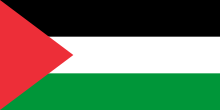الفلسطينيون al-Filasṭīnīyūn | |
|---|---|
 | |
| Total population | |
| c. 13 million[1] | |
| Regions with significant populations | |
| 4,750,000[2][3][a] | |
| – West Bank | 2,930,000 (of whom 809,738 are registered refugees (2017))[4][5][6] |
| – Gaza Strip | 1,880,000 (of whom 1,386,455 are registered refugees (2018))[2][4][5] |
| 2,175,491 (2017, registered refugees only)[4]–3,240,000 (2009)[7] | |
| 1,890,000[8][9] (60% of Israeli Arabs identify as Palestinians (2012))[10] | |
| 552,000 (2018, registered refugees only)[4] | |
| 500,000[11] | |
| 174,000 (2017 census)[12]–458,369 (2016 registered refugees)[4] | |
| 400,000[13] | |
| 295,000[13] | |
| 255,000[14] | |
| 91,000[13] | |
| 80,000[15] | |
| 80,000[16] | |
| 70,000[13] | |
| 70,000[17] | |
| 59,000[18] | |
| 59,000[13] | |
| 57,000[19] | |
| 50,975[20] | |
| 29,000[13] | |
| 27,000–200,000[13][21] | |
| 20,000[15] | |
| 15,000[citation needed] | |
| 13,000[13] | |
| 12,000[13] | |
| 9,000–15,000[22] | |
| 7,000 (rough estimate)[23][24] | |
| 7,000[25] | |
| 4,030[26] | |
| Languages | |
| Palestine and Israel: Palestinian Arabic, Hebrew, English and Greek Diaspora: Other varieties of Arabic, the vernacular languages of other countries in the Palestinian diaspora | |
| Religion | |
| Majority: Sunni Islam Minority: Christianity, Samaritanism,[27][28] Druze, Shia Islam, non-denominational Muslims[29] | |
| Related ethnic groups | |
| Other Levantines, other Semitic-speaking peoples, Jews (Ashkenazim, Mizrahim, Sephardim), Assyrians, Samaritans, other Arabs, and other Mediterranean peoples.[30] | |
- ^ "More than 13m Palestinians in the world by end of 2018". Middle East Monitor. 1 January 2019.
- ^ a b 'PCBS: The Palestinians at the end of 2015,' 30 December 2015
- ^ Cite error: The named reference
PCBSwas invoked but never defined (see the help page). - ^ a b c d e "Where We Work".
- ^ a b 'PCBS reports Palestinian population growth to 4.81 million,' Ma'an News Agency 11 July 2016.
- ^ 'The World Fact Book CIA July 2015.
- ^ "Palestinian Central Bureau of Statistics (PCBS) Press Release" (PDF).
- ^ Luke Baker, 'Population parity in historic Palestine raises hard questions for Israel,' Reuters 10 September 2015.
- ^ "Israel's Independence Day 2019" (PDF). Israel Central Bureau of Statistics. 1 May 2019. Retrieved 25 May 2019.
- ^ Arlosoroff, Meirav (2 July 2016). "60% מערביי ישראל מגדירים עצמם פלסטינים" [60% of Israeli Arabs define themselves as Palestinians]. TheMarker. Retrieved 26 June 2016.
- ^ Cite error: The named reference
laventana1was invoked but never defined (see the help page). - ^ "Lebanon conducts first-ever census of Palestinian refugees". 21 December 2017.
- ^ a b c d e f g h i "The Arab, Palestinian people group is reported in 25 countries". Joshua Project. Retrieved 26 June 2016.
- ^ "U.S. Census website". United States Census Bureau. Retrieved 22 April 2009.
- ^ a b "The Palestinian Diaspora in Europe". Archived from the original on 24 August 2013. Retrieved 22 June 2011.
- ^ "Palestinians Open Kuwaiti Embassy". Al Monitor. 23 May 2013. Archived from the original on 22 May 2013. Retrieved 23 May 2013.
- ^ "Tim's El Salvador Blog".
- ^ "test0.com". Archived from the original on 23 March 2009.
- ^ "Archived copy". Archived from the original on 20 July 2009. Retrieved 16 June 2009.
{{cite web}}: CS1 maint: archived copy as title (link) - ^ "Ethnic Origin (247), Single and Multiple Ethnic Origin Responses (3) and Sex (3) for the Population of Canada, Provinces, Territories, Census Metropolitan Areas and Census Agg." 2.statcan.ca. Retrieved 22 April 2009.
- ^ Jorge Alberto Amaya, Los Árabes y Palestinos en Honduras: su establecimiento e impacto en la sociedad hondureña contemporánea:1900–2009 Archived 18 August 2016 at the Wayback Machine 23 July 2015.'En suma, los árabes y palestinos, arribados al país a finales del siglo XIX, dominan hoy en día la economía del país, y cada vez están emergiendo como actores importantes de la clase política hondureña y forman, después de Chile, la mayor concentración de descendientes de palestinos en América Latina, con entre 150,000 y 200,000 personas.'
- ^ "Did you know that ... Palestinians in the Netherlands – Palestine Link". Archived from the original on 4 November 2018. Retrieved 4 November 2018.
- ^ "Archived copy" (PDF). Archived from the original (PDF) on 2 November 2012. Retrieved 21 May 2011.
{{cite web}}: CS1 maint: archived copy as title (link) - ^ "Australians' Ancestries" (PDF).
- ^ Miguel Benito. "Palestinier". Archived from the original on 29 July 2013.
- ^ "2013 UNHCR country operations profile – Algeria". United Nations High Commissioner for Refugees. 2013. Retrieved 22 December 2013.
- ^ Mor, M., Reiterer, F. V., & Winkler, W. (2010). Samaritans: Past and present: Current studies. Berlin: De Gruyter. p. 217.
- ^ Miller, Elhanan (26 April 2013). "Clinging to ancient traditions, the last Samaritans keep the faith". The Times of Israel. Retrieved 16 February 2016.
- ^ Chapter 1: Religious Affiliation retrieved 4 September 2013
- ^ Cruciani, F; et al. (2007). "Tracing Past Human Male Movements in Northern/Eastern Africa and Western Eurasia: New Clues from Y-Chromosomal Haplogroups E-M78 and J-M12". Molecular Biology and Evolution. 24 (6): 1300–1311. doi:10.1093/molbev/msm049. PMID 17351267. Also see Supplementary Data Archived 5 December 2012 at archive.today
Cite error: There are <ref group=lower-alpha> tags or {{efn}} templates on this page, but the references will not show without a {{reflist|group=lower-alpha}} template or {{notelist}} template (see the help page).